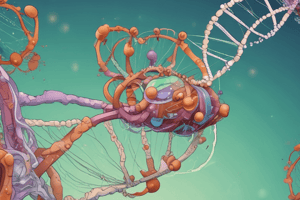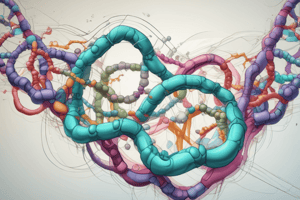Podcast
Questions and Answers
During transcription, which of the following bases in DNA would pair with adenine (A) in mRNA?
During transcription, which of the following bases in DNA would pair with adenine (A) in mRNA?
- Guanine (G)
- Cytosine (C)
- Thymine (T)
- Uracil (U) (correct)
Replication results in a simplified version of the original DNA, creating mRNA.
Replication results in a simplified version of the original DNA, creating mRNA.
False (B)
In the central dogma of molecular biology, what is the main purpose of translation?
In the central dogma of molecular biology, what is the main purpose of translation?
protein synthesis
The tRNA binding site on the ribosome, where tRNA initially binds during translation, is known as the ______.
The tRNA binding site on the ribosome, where tRNA initially binds during translation, is known as the ______.
Match the type of RNA with its primary function:
Match the type of RNA with its primary function:
Flashcards
DNA
DNA
Deoxyribonucleic acid is a molecule that carries genetic instructions for all living organisms.
Replication
Replication
The process of creating an exact copy of the original DNA molecule.
RNA
RNA
RNA is a nucleic acid present in all living cells, and its principal role is to act as a messenger carrying instructions from DNA for controlling the synthesis of proteins.
Transcription
Transcription
Signup and view all the flashcards
Translation
Translation
Signup and view all the flashcards
Study Notes
- DNA stands for deoxyribonucleic acid, featuring a double helix shape.
- RNA stands for ribonucleic acid.
Nitrogenous Bases and Base Pairing
- Guanine pairs with cytosine.
- Adenine pairs with thymine in DNA, and uracil in RNA.
Sugars
- DNA contains deoxyribose sugar.
- RNA contains ribose sugar.
Location
- DNA is found in the nucleus.
- RNA is located in the nucleus, cytoplasm, and mitochondria.
Structure
- DNA has a double helix structure.
- RNA consists of a single strand.
RNA Base Pairing
- In RNA, uracil (U) pairs with adenine (A), and cytosine (C) pairs with guanine (G).
RNA Types
- Messenger RNA (mRNA) carries genetic information from DNA to ribosomes.
- Ribosomal RNA (rRNA) is a component of ribosomes.
- Transfer RNA (tRNA) transfers amino acids to the ribosome for protein synthesis.
Central Dogma of Molecular Biology
- Describes the process of protein production from DNA, involving replication, transcription, and translation.
Replication
- The original genetic information is copied to ensure each new cell has identical information to the parent cell.
Transcription
- DNA is converted into mRNA.
- Occurs in the nucleus of eukaryotic cells.
Translation Sites
- E site is the exit site for tRNA.
- P site (peptidyl-tRNA binding site) is where tRNA binds.
- A site (aminoacyl-tRNA binding site) is where tRNA binds.
Translation
- Translation occurs at the E, P and A- Site.
Studying That Suits You
Use AI to generate personalized quizzes and flashcards to suit your learning preferences.
Description
Explore the key differences between DNA and RNA, focusing on their structure, nitrogenous bases, and location within the cell. Understand the roles of mRNA, rRNA, and tRNA in protein synthesis and the central dogma of molecular biology.




